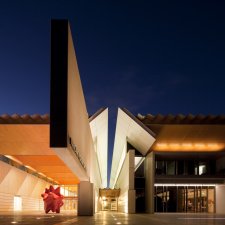- About us
- Support the Gallery
- Venue hire
- Publications
- Research library
- Organisation chart
- Employment
- Contact us
- Make a booking
- Onsite programs
- Online programs
- School visit information
- Learning resources
- Little Darlings
- Professional learning
Binem (Bill) Grunstein (1921-2013), garment manufacturer and artist, escaped the Warsaw Ghetto in 1941, having seen his parents and most of his family members die of typhus or disappear. (At the beginning of the war there were more than 350 000 Jews living in Warsaw; at the end, there were about 11 500). Grunstein escaped to a farm, where he was concealed and employed from 1942 to 1943. When joined by his brother Mark, he had to leave; the pair were captured and taken to concentration camps. In all, Grunstein was in fourteen camps, including Dachau. Throughout the war, on a scrap-metal cigarette box, he engraved the names of each camp, and the dates he was there; the box is now in the Holocaust Museum, Washington DC. In various camps Grunstein made aeroplane parts, drew calligraphy, wrote sign notices and cut bread, but his talent for painting contributed significantly to his survival; he made many portraits of Nazi officers. After the war, in a displaced persons’ camp in Eggenfelden, Germany, he met Chana (Hania) Bornstein, his future wife. She went to Sweden, but he was refused entry; instead, he and Mark set sail for Australia, the first country by which they happened to have been accepted. They arrived in Australia in May 1949, speaking no English; Binem served his mandatory two years’ labour washing dishes for the Australian Army in Casula. In 1951, Hania joined him; they lived in a one-bedroom flat in Bondi Junction with Mark, and in due course their two children, Harry and Sarah. Binem continued his dishwashing for an extra year, but as Hania was skilled in tailoring, at night the couple made patterns, cut out and sewed dresses. One of the first businessmen to give them work was Leo Berkeley of the famed ‘House of Mink’ at Burwood; within six months of supplying Berkeley with thirty dresses the couple had thirty employees. In time, Grunstein studied fashion design and art at East Sydney Technical College. Every weekend, he painted; over succeeding decades he became a teacher, fellow and director of the Royal Art Society, with which he frequently exhibited views of Sydney. Binem outlived Hania by 14 years. Sarah Grunstein is a New-York based pianist of international reputation; Harry Grunstein is an endocrinologist in Sydney.
Collection: National Portrait Gallery
Gift of Harry Grunstein and Sarah Grunstein in memory of their father 2015
Binem Grunstein (age 27 in 1948)



On one level The Companion talks about the most famous and frontline Australians, but on another it tells us about ourselves.



Visit us, learn with us, support us or work with us! Here’s a range of information about planning your visit, our history and more!



We depend on your support to keep creating our programs, exhibitions, publications and building the amazing portrait collection!